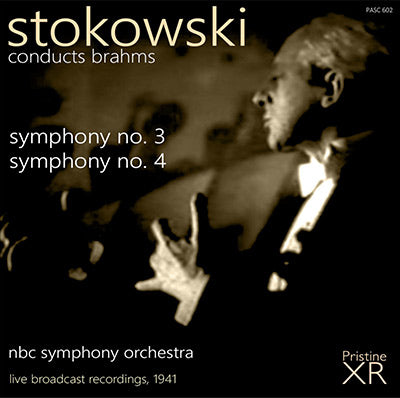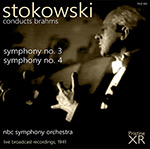
This album is included in the following sets:
This set contains the following albums:
- Producer's Note
- Full Track Listing
- Cover Art
conducts Brahms at the NBC
"Joy!" exclaimed W. R. Anderson in the Gramophone of July 1930, "Brahms's Third at long last. Our prayers have prevailed." He was reacting with delight to the first complete 78rpm set of the work in which Leopold Stokowski conducted the Philadelphia Orchestra. The review concluded enthusiastically: "This is a grand orchestra and a constructive conductor; and in this music of fine nerve and developed muscle we find fullness of joy."
Stokowski began his 60-year recording career in 1917 with acoustic 78s of Brahms's Hungarian Dances Nos. 5 and 6 (PASC192). In 1921 he made the first recording of any of the movements in Brahms's symphonies, the 3rd Symphony's Allegretto (PASC476). With the advent of electrical recording, the Philadelphians under his direction became the first orchestra to record a complete cycle of all four symphonies (1927-1933). (No. 1: PASC500; No.3: PASC540; Nos 2 & 4: PASC562).
Stokowski once confessed that he "always wanted to be first" and Brahms featured in quite a few of his first engagements over the years. He played a Brahms symphony for the first time - the 3rd - in his debut season with the Cincinnati Orchestra in 1909. Three years later, he conducted the London Symphony in another debut, this time featuring the 1st Symphony. Also in 1912 came another new appointment, as the Philadelphia Orchestra's chief conductor, and the Brahms 1st was played in his debut concert with them.
Fast forward to 1941 and Stokowski's three-season appointment as the NBC Symphony's chief conductor following Toscanini's temporary withdrawal. In his first NBC concert, it was Brahms who yet again featured in a Stokowski debut, with the 3rd Symphony presented here. In his introduction, he spoke of the work's contrasting moods: "Fiery agitation, melancholy, tranquillity, childlike simplicity." Following a genuine Allegro con brio at the start, these moods were then illustrated by some extreme tempo changes. Various musicologists consider this work "difficult to bring off" but for his part, Stokowski's somewhat rhapsodic approach, as evidenced in his two commercial recordings and also this broadcast, was notably consistent.
In the case of the Brahms 4th Symphony, Stokowski's performances were invariably speedy, with the codas to the Allegro movements having the stringendo pedal forcefully applied each time. As it happens, it was the Brahms 4th which Stokowski conducted in his final UK public concert in 1974. "A performance to set one cheering" wrote Edward Greenfield in The Guardian, "as indeed the audience did after the first movement."
Even at the age of 95, Stokowski hadn't quite finished with Brahms. In 1977 he recorded the 2nd Symphony with the National Philharmonic Orchestra. Mortimer Frank in Fanfare hailed it as "a great Brahms Second," while in Classic Record Collector, Robin Golding remarked: "For me, Stokowski has suddenly become a conductor of world class." Some of us knew he was that the first time we heard him!
Edward Johnson
STOKOWSKI conducts Brahms
1. STOKOWSKI Introduction to Brahms Symphony No. 3 (1:17)
BRAHMS Symphony No. 3 in F, Op. 90
2. 1st mvt. - Allegro con brio (9:24)
3. 2nd mvt. - Andante (10:22)
4. 3rd mvt. - Poco allegretto (5:59)
5. 4th mvt. - Allegro (8:40)
Concert of 4 November 1941
6. STOKOWSKI Introduction to Brahms Symphony No. 4 (1:50)
BRAHMS Symphony No. 4 in E minor, Op. 98
7. 1st mvt. - Allegro non troppo (10:50)
8. 2nd mvt. - Andante moderato (11:18)
9. 3rd mvt. - Allegro giocoso (5:40)
10. 4th mvt. - Allegro energico e passionato (9:38)
Concert of 18 November 1941
NBC Symphony Orchestra
conducted by Leopold Stokowski
XR Remastered by Andrew Rose
Live broadcast recordings from the Cosmopolitan Opera House, New York
Cover artwork based on a photograph of Leopold Stokowski
Total duration: 74:58

